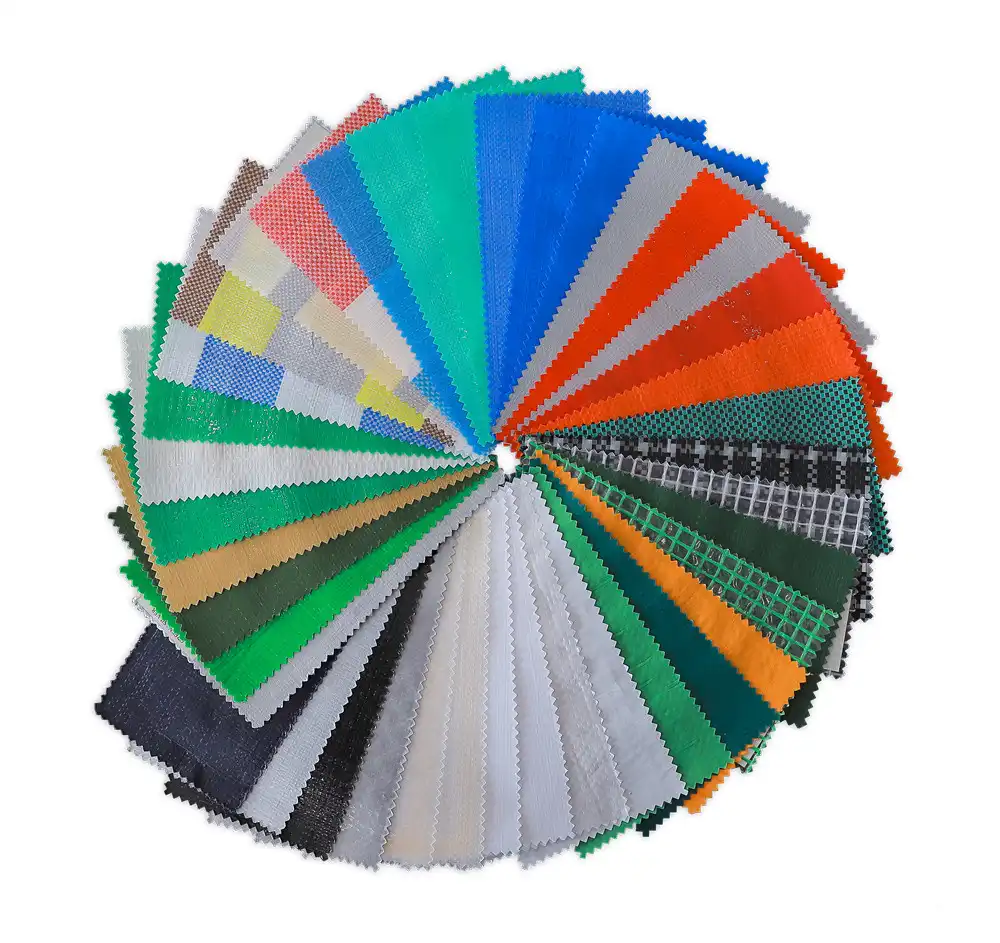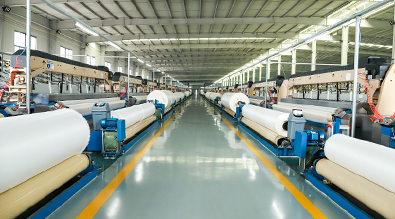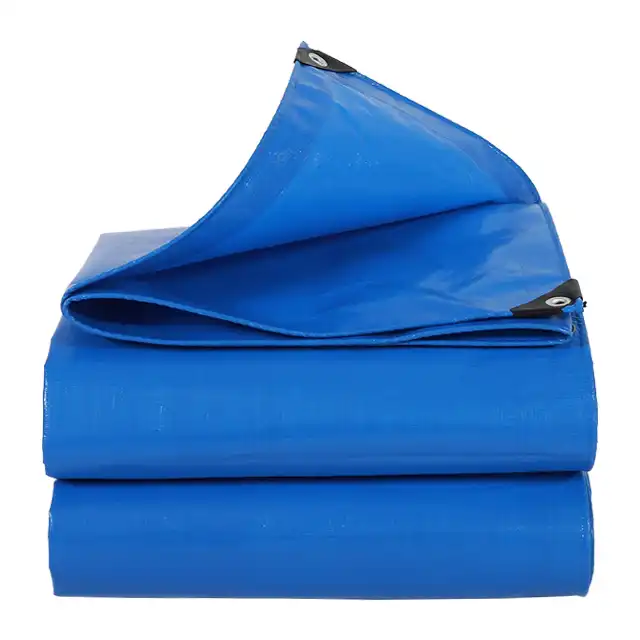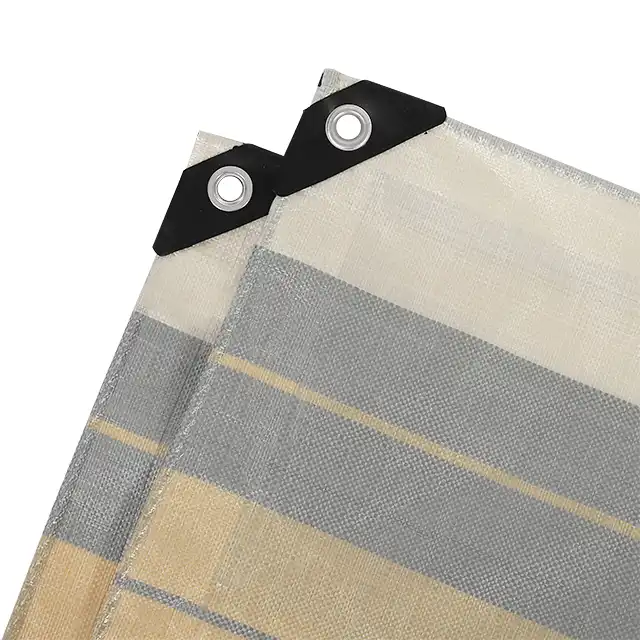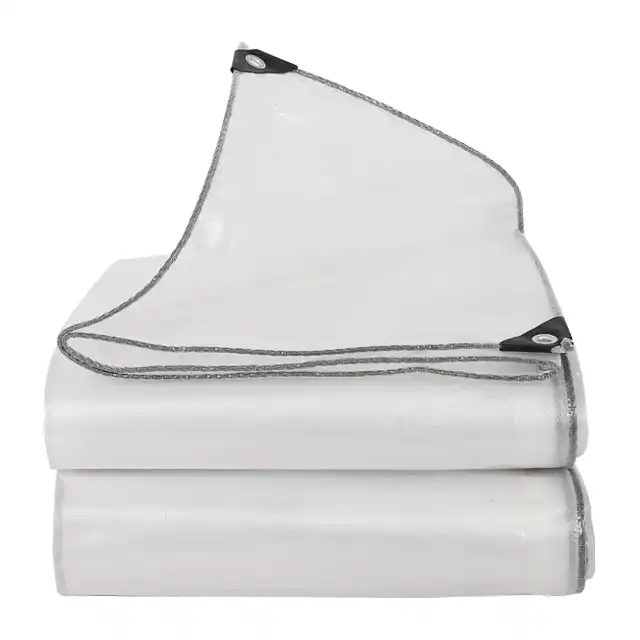How to Choose the Right Size Tarpaulin for Your Truck?
Picture this: you're halfway through your delivery route when you notice your cargo getting soaked from unexpected rain, or worse, you're watching your expensive equipment bounce around unprotected because your tarp doesn't fit properly. Choosing the wrong size truck tarpaulin can cost you thousands in damaged goods, regulatory fines, and lost customer trust. Whether you're a fleet manager responsible for multiple vehicles or an independent trucker looking to protect your livelihood, selecting the right tarpaulin size is crucial for operational success. This comprehensive guide will walk you through every aspect of choosing the perfect truck tarpaulin dimensions, ensuring your cargo stays secure, dry, and compliant with transportation regulations.
Understanding Truck Tarpaulin Sizing Fundamentals
 The foundation of selecting the right truck tarpaulin begins with understanding how sizing works in the transportation industry. Professional truckers know that tarp sizing isn't simply about matching your truck bed dimensions, but rather about creating a complete protection system that accounts for cargo height, securing methods, and operational requirements. The most critical measurement factor is determining your truck's actual coverage area, which includes not just the flatbed length and width, but also the maximum height your cargo might reach during transport. When measuring for truck tarpaulin sizing, professional drivers typically add 2-4 feet to their bed length and 1-2 feet to width measurements. This additional material provides adequate drape for side coverage and ensures proper securing without creating stress points that could lead to tearing. The standard truck tarpaulin sizes commonly range from 16x20 feet for smaller pickup trucks to massive 24x27 feet covers for heavy-duty commercial vehicles. However, custom sizing has become increasingly important as specialized cargo requirements demand more precise fitting solutions. Cargo height considerations play an equally important role in truck tarpaulin selection. Flatbed truckers hauling lumber, machinery, or construction materials must account for load heights that can vary significantly from one shipment to another. A properly sized truck tarpaulin should provide enough material to drape over the highest point of your cargo while still reaching down to create secure anchor points along the truck bed edges. Professional transportation companies often maintain multiple tarp sizes to accommodate different cargo configurations efficiently.
The foundation of selecting the right truck tarpaulin begins with understanding how sizing works in the transportation industry. Professional truckers know that tarp sizing isn't simply about matching your truck bed dimensions, but rather about creating a complete protection system that accounts for cargo height, securing methods, and operational requirements. The most critical measurement factor is determining your truck's actual coverage area, which includes not just the flatbed length and width, but also the maximum height your cargo might reach during transport. When measuring for truck tarpaulin sizing, professional drivers typically add 2-4 feet to their bed length and 1-2 feet to width measurements. This additional material provides adequate drape for side coverage and ensures proper securing without creating stress points that could lead to tearing. The standard truck tarpaulin sizes commonly range from 16x20 feet for smaller pickup trucks to massive 24x27 feet covers for heavy-duty commercial vehicles. However, custom sizing has become increasingly important as specialized cargo requirements demand more precise fitting solutions. Cargo height considerations play an equally important role in truck tarpaulin selection. Flatbed truckers hauling lumber, machinery, or construction materials must account for load heights that can vary significantly from one shipment to another. A properly sized truck tarpaulin should provide enough material to drape over the highest point of your cargo while still reaching down to create secure anchor points along the truck bed edges. Professional transportation companies often maintain multiple tarp sizes to accommodate different cargo configurations efficiently.
-
Weight Distribution and Material Thickness
The relationship between tarp size and material weight significantly impacts both performance and handling efficiency. Larger truck tarpaulin covers naturally weigh more, but the material thickness (measured in GSM - grams per square meter) also affects the overall weight distribution across your vehicle. Heavy-duty polyethylene tarpaulins typically range from 150-400 GSM, with thicker materials providing superior durability but requiring more physical effort during installation and removal processes. Professional drivers understand that oversized tarpaulins create unnecessary weight burdens and can lead to handling difficulties during windy conditions. Conversely, undersized covers create dangerous situations where cargo remains partially exposed or securing points become overstressed. The optimal truck tarpaulin size strikes a balance between complete coverage and manageable installation, considering both the driver's physical capabilities and mechanical securing systems. Material thickness also impacts how the tarpaulin behaves in different weather conditions. Thicker truck tarpaulin materials resist wind flutter and maintain better shape retention, but they also create more air resistance during highway travel. Transport companies increasingly consider fuel efficiency implications when selecting tarpaulin sizes, as oversized covers can measurably impact diesel consumption over long-haul routes.
Measuring Your Truck for Proper Tarpaulin Fit
Accurate measurement forms the cornerstone of successful truck tarpaulin selection, yet many operators rush through this crucial step and later face costly consequences. Professional measurement begins with your truck bed in its typical loading configuration, accounting for any permanent fixtures like headache racks, side rails, or specialized mounting hardware. The measurement process should always occur with the truck parked on level ground and all systems in their normal operating positions. Length measurement for truck tarpaulin sizing starts from the front headboard or cab protector and extends to the rear of the bed, including any permanent extensions or overhangs. Many experienced truckers add an extra 12-18 inches to this base measurement to ensure adequate coverage for varying cargo configurations. The width measurement includes the full bed width plus any side rails or permanent fixtures that the tarp must clear during installation. Professional operators typically add 6-12 inches to width measurements to provide secure anchoring points below the bed line. Height considerations require measuring the maximum vertical clearance your cargo typically requires. This measurement starts from the truck bed surface and extends to the highest point your loads normally reach. However, smart operators also consider occasional oversized loads that might require additional clearance. The truck tarpaulin must provide enough material to create a proper drape over maximum height cargo while still maintaining secure edge attachment points.
-
Advanced Measuring Techniques for Specialized Applications
Specialized truck configurations require more sophisticated measuring approaches to ensure optimal tarpaulin fit. Trucks equipped with crane systems, specialized racks, or custom cargo containment systems need careful measurement of all protruding elements that could interfere with tarp installation or create potential damage points. Professional measurement includes mapping all sharp edges, mounting hardware, and mechanical systems that could contact the tarpaulin during use. Multi-axle trailers and extended-length configurations present unique measuring challenges that require sectional measurement approaches. These applications often benefit from custom truck tarpaulin solutions that accommodate specific geometric requirements while maintaining structural integrity across extended spans. Experienced operators create detailed measurement diagrams that include all critical dimensions and potential interference points for reference during tarp selection and installation. Temperature variation effects on measurement accuracy become particularly important in regions with extreme seasonal changes. Metal truck beds expand and contract with temperature variations, while tarpaulin materials also exhibit dimensional changes under different thermal conditions. Professional operators account for these variables by taking measurements under representative operating conditions and adding appropriate safety margins to accommodate thermal expansion and contraction cycles.
Truck Tarpaulin Size Standards and Industry Requirements
The transportation industry operates under specific regulatory frameworks that directly impact truck tarpaulin size requirements and selection criteria. Department of Transportation regulations mandate that cargo securement systems, including tarpaulins, meet specific performance standards for strength, coverage, and attachment methods. These regulations influence not only the minimum size requirements but also the quality standards that commercial truck tarpaulin must meet for legal compliance. Standard truck tarpaulin sizes have evolved to match common truck bed configurations and regulatory requirements efficiently. The most prevalent sizes include 16x20 feet for standard pickup trucks, 20x24 feet for medium-duty commercial vehicles, and 24x27 feet for heavy-duty flatbed trailers. However, the trucking industry increasingly demands custom sizing solutions to optimize cargo protection while minimizing weight and handling complexity. Regional variations in truck tarpaulin size standards reflect different transportation requirements and environmental conditions. European markets favor different sizing conventions compared to North American standards, while emerging markets often develop regional preferences based on local truck manufacturing standards and cargo types. Understanding these variations becomes crucial for companies operating across multiple geographic regions or sourcing tarpaulins from international suppliers.
-
Compliance and Safety Considerations
Safety regulations significantly influence truck tarpaulin size selection beyond basic coverage requirements. Oversized tarpaulins create wind loading hazards that can affect vehicle stability and control, particularly during highway travel in adverse weather conditions. Regulatory authorities increasingly scrutinize cargo securement systems for compliance with updated safety standards that address wind resistance, load distribution, and emergency response accessibility. Professional transportation companies implement comprehensive truck tarpaulin sizing protocols that ensure compliance with current regulations while optimizing operational efficiency. These protocols include regular reviews of sizing standards against regulatory updates and systematic evaluation of tarp performance under various operating conditions. Compliance documentation becomes increasingly important as enforcement agencies implement more sophisticated inspection procedures for cargo securement systems. Insurance considerations also impact truck tarpaulin size selection, as coverage policies often specify minimum requirements for cargo protection systems. Undersized or improperly fitted tarpaulins can void insurance coverage in case of cargo damage claims, making proper sizing a critical financial protection strategy. Professional operators maintain detailed records of tarp specifications and sizing rationale to support insurance claims and regulatory compliance documentation.
Material Selection Impact on Truck Tarpaulin Sizing
The choice of tarpaulin material significantly affects sizing requirements and performance characteristics, making material selection an integral part of the sizing decision process. Polyethylene truck tarpaulin materials offer different stretch characteristics, wind resistance properties, and installation flexibility compared to PVC or canvas alternatives. These material differences directly impact the amount of extra material needed for proper coverage and secure installation. High-density polyethylene materials commonly used in truck tarpaulin applications provide excellent durability while maintaining reasonable flexibility for installation and storage. These materials typically require less additional sizing allowance because they conform better to cargo shapes and maintain stable dimensions under load. The material's inherent strength allows for more precise sizing without compromising coverage security or attachment point integrity. Specialized coating applications on truck tarpaulin materials can affect sizing requirements by changing the material's flexibility and conformability characteristics. UV-resistant coatings, anti-static treatments, and fire-retardant applications each impact how the material behaves during installation and use. Professional operators consider these material modifications when calculating appropriate sizing allowances and storage requirements.
-
Weather Resistance and Seasonal Considerations
Different truck tarpaulin materials exhibit varying responses to temperature extremes, humidity, and precipitation exposure. These environmental responses directly affect sizing calculations, particularly for operations in regions with extreme seasonal variations. Cold weather operation requires additional sizing allowance as materials become less flexible and more prone to cracking under stress. Heavy-duty truck tarpaulin materials designed for extended outdoor exposure often incorporate reinforcing elements that affect flexibility and installation requirements. Mesh reinforcing, edge binding systems, and attachment hardware all influence the effective coverage area and sizing calculations. Professional transportation companies evaluate these factors as part of comprehensive tarp selection protocols that account for specific operational environments and cargo requirements. Wind resistance characteristics vary significantly between different truck tarpaulin materials and directly impact sizing optimization. Materials with superior wind resistance can often be used in smaller sizes without compromising performance, while materials prone to wind flutter may require additional sizing to maintain stable coverage. This relationship between material properties and sizing requirements becomes particularly critical for high-speed highway transportation applications.
Installation and Securing Systems Impact on Size Selection
The method used to install and secure truck tarpaulin directly influences sizing requirements and operational efficiency. Manual installation systems require additional material for handling and positioning, while mechanical systems like roll tarps can operate with more precise sizing tolerances. Understanding these installation requirements helps optimize tarp size selection for specific operational configurations and crew capabilities. Manual tarpaulin installation on large trucks requires sufficient material to allow proper positioning without creating dangerous working conditions for installation crews. Professional operators typically add 12-18 inches to base measurements when planning for manual installation systems, providing adequate material for safe handling while maintaining complete cargo coverage. This additional sizing allowance also accommodates slight positioning errors during installation under challenging conditions. Mechanical tarp systems, including roll tarps and slide systems, operate with more precise sizing requirements but demand careful attention to clearance dimensions and mounting hardware compatibility. These systems typically require truck tarpaulin that matches specific width tolerances to ensure proper operation without binding or excessive wear. The length requirements for mechanical systems often include additional material for proper rolling or sliding action throughout the system's operational range.
-
Hardware Compatibility and Mounting Systems
Tarp mounting hardware significantly impacts sizing requirements and selection criteria for truck tarpaulin applications. Bungee cord systems, ratchet straps, and permanent mounting hardware each create different sizing demands based on attachment point locations and securing method requirements. Professional operators evaluate these hardware relationships during the sizing selection process to ensure optimal performance and longevity. Grommet spacing and reinforcement requirements directly affect truck tarpaulin sizing calculations, particularly for applications requiring frequent installation and removal. Standard grommet spacing typically occurs every 18-24 inches along tarp edges, but specialized applications may require custom spacing that affects overall sizing optimization. The relationship between grommet placement and truck bed configuration influences both sizing selection and attachment point planning. Edge reinforcement systems used in heavy-duty truck tarpaulin applications add material bulk that affects sizing calculations and installation requirements. Heat-sealed edges, rope reinforcement, and binding systems each create different dimensional requirements that professional operators must consider during size selection. These reinforcement systems also affect the effective coverage area by influencing how the material drapes and conforms to cargo shapes.
Cost Optimization Through Proper Size Selection
Selecting the optimal truck tarpaulin size directly impacts both initial investment costs and long-term operational expenses. Oversized tarpaulins increase material costs, shipping expenses, and storage requirements while potentially reducing fuel efficiency through increased wind resistance. Conversely, undersized covers create risk of cargo damage claims and regulatory violations that can far exceed the initial cost savings. Professional fleet management approaches truck tarpaulin size selection as a total cost of ownership decision that considers purchase price, installation labor, fuel impact, and replacement frequency. This comprehensive analysis often reveals that moderate premium pricing for properly sized, high-quality tarpaulins delivers superior value compared to lowest-cost alternatives that may require frequent replacement or create operational complications. Custom sizing options increasingly provide cost-effective solutions for specialized truck configurations or high-volume applications. While custom truck tarpaulin sizing typically involves higher per-unit costs, the improved fit and performance often justify the investment through reduced installation time, improved cargo protection, and extended service life. Professional transportation companies increasingly specify custom sizing for their core fleet applications while maintaining standard sizes for backup and specialty use.
-
Maintenance and Replacement Cost Considerations
Properly sized truck tarpaulin typically exhibits extended service life compared to oversized or undersized alternatives. Oversized tarpaulins experience excessive wear from wind flutter and handling stress, while undersized covers suffer from overstress conditions that accelerate material failure. Optimal sizing selection minimizes these stress factors and maximizes the return on tarpaulin investment. Repair cost implications vary significantly based on truck tarpaulin size selection and usage patterns. Larger tarpaulins require more extensive repair procedures and material replacement when damage occurs, while smaller tarpaulins may be more economically replaced rather than repaired. Professional operators evaluate these maintenance cost relationships when selecting optimal sizing for specific applications and usage intensity levels. Storage and handling costs scale directly with truck tarpaulin size, affecting both facility requirements and labor efficiency. Oversized tarpaulins require larger storage areas, heavier handling equipment, and increased installation labor compared to properly sized alternatives. These operational cost factors often justify moderate premiums for optimal sizing that improves handling efficiency and storage requirements.
Conclusion
Selecting the right size truck tarpaulin requires careful consideration of multiple interconnected factors including precise measurements, material properties, installation systems, regulatory compliance, and cost optimization. Professional success depends on understanding that tarpaulin sizing is not simply about matching truck bed dimensions, but rather creating a comprehensive cargo protection system that balances coverage requirements with operational efficiency. By following the systematic approach outlined in this guide, truck operators can ensure optimal tarpaulin performance while minimizing costs and maximizing cargo protection throughout their transportation operations.
Cooperate with Linyi Shengde Plastic Co., Ltd.
As a leading China Truck Tarpaulin factory established in 2003, Linyi Shengde Plastic Co., Ltd. brings over two decades of expertise to truck tarpaulin manufacturing with registered capital of RMB 60 Million across 60,000 square meters of advanced production facilities. Our reputation as a premier China Truck Tarpaulin supplier stems from partnerships with international organizations like UNHCR, IOM, ICRC, and UNICEF, demonstrating our commitment to quality and reliability. With over 400 Korea-imported automatic water-jet looms and professional coating machines, we deliver High Quality Truck Tarpaulin solutions that meet diverse transportation needs. Our experienced R&D team develops innovative features like fire prevention and enhanced waterproof functions, ensuring our Truck Tarpaulin for sale meets evolving industry demands. Contact us at info@shengdetarp.com for competitive Truck Tarpaulin price quotes and discover why we're the preferred China Truck Tarpaulin manufacturer and China Truck Tarpaulin wholesale partner for transportation professionals worldwide.
FAQ
Q: What is the standard size truck tarpaulin for an 18-wheel flatbed truck?
A: Most 18-wheel flatbed trucks use 24×27 feet tarpaulins, though exact size depends on trailer length and typical cargo height requirements.
Q: How much extra length should I add to my truck bed measurement for proper tarp coverage?
A: Add 2-4 feet to length and 1-2 feet to width measurements to ensure adequate drape and secure attachment points.
Q: Can I use the same tarpaulin size for different cargo types on my truck?
A: While possible, different cargo heights and shapes may require different tarp sizes for optimal protection and regulatory compliance.
Q: What GSM rating should I choose for heavy-duty truck tarpaulin applications?
A: Heavy-duty applications typically require 200-400 GSM polyethylene tarpaulins for optimal durability and weather resistance.
References
1. "Commercial Vehicle Tarpaulin Sizing Standards" - Transportation Safety Administration, Federal Motor Carrier Safety Administration
2. "Cargo Securement Systems: Best Practices for Tarpaulin Selection" - American Transportation Research Institute, Commercial Vehicle Safety Alliance
3. "Polyethylene Tarpaulin Material Specifications for Transportation Applications" - Society of Plastics Engineers, Materials Engineering Division
4. "Fleet Management Guide to Tarpaulin Cost Optimization" - National Private Truck Council, Fleet Equipment Magazine
